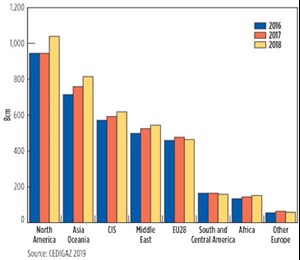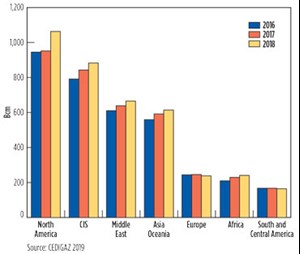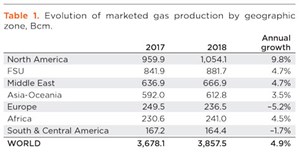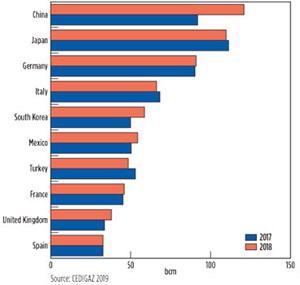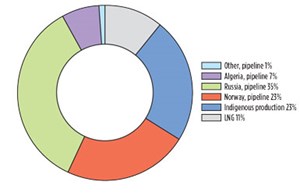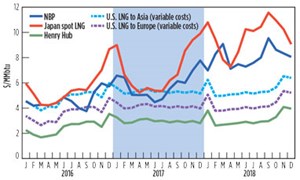Global gas market grew rapidly in 2018
Global natural gas demand surged 4.7% during 2018, to 3.850 Tcm, driven by output in the U.S. and imports to China. The U.S. was the standout performer, accounting for 45% of the global increase, as relates to both the consumption and supply of natural gas.
And 2018 marks the second year of strong growth in natural gas demand, after a 3.5 % rise in 2017. It also recorded the highest growth in gas demand since the post-crisis rebound of 2010.
This fast expansion was driven by the abundance of competitive gas supply, especially in the U.S. and Russia, and by supportive energy and environmental policies, in some countries, particularly in China. Investment in transportation infrastructure also contributed to bolstering gas penetration in key markets.
China became the largest net importer of natural gas in the world, ahead of Japan. Chinese net imports jumped 32% and accounted for more than 80% of the global increase in net imports. This once again highlights the crucial role that China plays in absorbing global gas production.
Similar to 2017, the expansion of natural gas demand was part of substantial growth in world energy demand, driven by a robust global economy and extreme weather conditions. Strong gas demand growth in Asia contributed to a rise in market prices in key areas, and prevented the formation of a global LNG bubble.
EXCEPTIONAL DEMAND GROWTH DRIVEN BY THE U.S. AND CHINA
Global gas consumption grew 4.7% to 3.850 Tcm, pursuing the acceleration initiated in 2017, Fig. 1. Demand was boosted by a conjunction of weather, economic and policy factors. More than 45% of the global growth in gas demand occurred in the U.S., where extreme weather conditions lifted electricity demand and residential gas consumption.
Gas demand in China, up 40 Bcm, spurted higher for the second year in a row, driven by coal-to-gas switching policies. Demand was also well above average in India, Russia and the Middle East.
PRODUCTION SURGED
Global marketed natural gas production (Fig. 2, Table 1) grew 4.9%, to an all-time high of 3.857 Tcm in 2018, with record net additions of 180 Bcm. The U.S., alone, accounted for almost half of the total growth (+89 Bcm) thanks to a remarkable jump in domestic production (+11.5%), due entirely to shale gas. Outside the U.S., robust production additions were posted in Russia, Iran, Australia, China and Egypt. The largest declines were recorded in the Netherlands (Groningen cap) and Venezuela. Europe was the only region that saw a substantial reduction in output, with declines in every main country.
INTERNATIONAL GAS FLOWS EXPANDED STRONGLY
International gas trade (net flows) grew a strong 3.7%, to 973 Bcm (Fig. 3), thanks to the LNG trade. Indeed, LNG continued its expansion wave, although at a slower pace than in 2017, up 8.7% to 415 Bcm. The growth in LNG import flows was again propelled by Asia and particularly by China, the latter up 21 Bcm. As a result, LNG’s share of total international gas flows increased to a third. Conversely, pipeline trade growth was limited to 0.3%, essentially because of reduced intra-European gas flows against the backdrop of declining demand.
Growth in international trade came from net interregional flows—long-distance transportation needed to accommodate European and Asian markets—which jumped 11% to almost 500 Bcm. Asia was responsible for more than 70% of the global increase, while Europe accounted for the rest. The former Soviet Union and, to a lesser extent, North America, contributed much of the growth in net inter-regional exports.
EU GAS SUPPLY DEFICIT CONTINUED TO RISE
The external dependence of the European Union (EU) continued to climb in 2018, with Russia as the main beneficiary, Fig. 4. Despite declining gas demand, falling production caused net imports from extra-regional sources to rise 3%, to 379 Bcm, accounting for 77% of EU gas supply. The UK became the leading EU gas producer, overtaking the Netherlands, where accelerated production decline at Groningen field turned the country from an exporter into a net gas importer. With Yamal LNG, Russia increased its market share to 36% of the EU’s supply, far ahead of Norway (23%) and other sources.
NATURAL GAS PRICES REBOUNDED
Natural gas prices rebounded in key markets during 2018, particularly Europe and Asia, Fig. 5. The increase in gas prices occurred in a general context of rising prices for all fossil fuels amid fast-growing energy demand. Higher coal, oil and—in Europe—CO2 prices, as well as a relatively tight LNG market, led to a general increase in gas prices.
The average NBP price settled at $8.1/MBtu, 39% higher than in 2017, while Asian spot prices rose similarly to $9.7/MBtu. In fourth-quarter 2018, ample LNG supplies, combined with warm weather, caused gas prices to plummet. Yet, U.S. spot prices increased from $3/MBtu in 2017 to $3.2/MBtu during 2018. They rebounded during the last quarter, due to low storage levels.
- Advancing offshore decarbonization through electrification of FPSOs (March 2024)
- What's new in production (February 2024)
- U.S. operators reduce activity as crude prices plunge (February 2024)
- U.S. producing gas wells increase despite low prices (February 2024)
- U.S. drilling: More of the same expected (February 2024)
- U.S. oil and natural gas production hits record highs (February 2024)
- Applying ultra-deep LWD resistivity technology successfully in a SAGD operation (May 2019)
- Adoption of wireless intelligent completions advances (May 2019)
- Majors double down as takeaway crunch eases (April 2019)
- What’s new in well logging and formation evaluation (April 2019)
- Qualification of a 20,000-psi subsea BOP: A collaborative approach (February 2019)
- ConocoPhillips’ Greg Leveille sees rapid trajectory of technical advancement continuing (February 2019)

